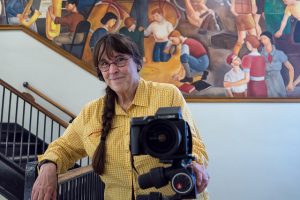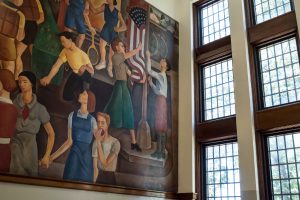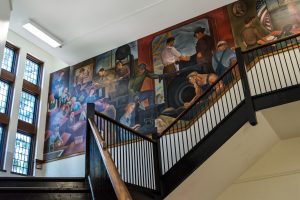Library of Congress Documents the Murals at Callanan

Photograph Carol Highsmith photographed murals at Callanan Middle School for the Library of Congress.
During the 1930s, photographer Dorothea Lange traveled the nation, capturing images on behalf of the Farm Security Administration. Her iconic photos humanized the impact of the Great Depression.
Carol Highsmith, herself a renowned photographer, looks to Lange as an inspiration and, in many ways, is following in her footsteps as she travels the country, documenting the United States in the 21st century for the Library of Congress. She is photographing the entire country on a state-by-state basis, capturing the unique beauty, energy and character of each state, over a number of years.
One of the pins in Highsmith’s well-worn map is now at Callanan Middle School.
She photographed two works of art at Callanan, murals painted at the school during the Great Depression under the auspices of the Works Progress Administration.
Highsmith’s photographs from Callanan, along with her entire body of work documenting America, are being donated to the Library of Congress – the largest library in the world – where it will be archived in perpetuity and made available to the public.
Why did she include Callanan Middle School among her stops? She finds WPA projects, such as the murals at Callanan, to be an important part of the nation’s cultural and artistic history that need to be documented, shared, and never lost to time. The remaining WPA artworks around the country are regular stops on her travels.
The murals at Callanan are located in the north and south stairways. One, painted in 1936 by George Groom, is called “Nation at Work.” The other, painted in 1937 by Glen Chamberlain, is called “Nation at Play.” The Iowa artist Grant Wood oversaw the WPA’s art programs.
Highsmith is no sullen or reclusive artist. To the contrary, she’s quick to strike up a conversation with anyone in earshot about everything from the inspiration for her work to the specifications of her high-tech camera. While a ladder was being located to disconnect a light causing a glare on one of the Callanan murals, she spoke with passion about not only capturing images that tell the story of America, but also making that record available to all.
The talent and skill of Highsmith in capturing America for posterity for the Library of Congress earns high praise from many quarters. Notes Richard Moe, president emeritus of the National Trust for Historic Preservation: “I can’t think of a better photographer to undertake this immensely important task of documenting America than Carol Highsmith. Her ability to capture the essence of the special places that define our nation is unparalleled.”
When her work is done, the Library of Congress estimates that Highsmith will have donated 100,000 images telling the story of this nation. And somewhere among the unfinished story of America will be a chapter from Callanan Middle School.
The photography archives at the Library of Congress includes the Civil War photos of Mathew Brady to works by such well-known photographers as the aforementioned Dorothea Lange, Walker Evans, Gordon Parks and others. To learn more, and to see the work Highsmith has donated to date, visit the Library’s online archives.







